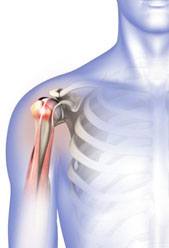
What is Proximal Biceps Tendinitis?
Proximal biceps tendinitis is the irritation and inflammation of the biceps tendon at the shoulder joint. The biceps muscle is the muscle of the upper arm which is necessary for the movement of the shoulder and elbow. It is made of a ‘short head’ and a ‘long head’ which function together. The long head of the biceps tendon is attached at the top of the shoulder joint. The short head is attached to your shoulder blade.
It usually is treated with a cortisone shot and physical therapy.
Causes
Proximal biceps tendinitis can be caused due to:
- Sports such as tennis and baseball
- Shoulder joint arthritis
- Glenoid labral tears
- Chronic shoulder dislocation
- Shoulder impingement
- Inflammation of shoulder joint
Symptoms
Initially, proximal biceps tenodesis is asymptomatic, but, as the disease progress, you may experience symptoms including:
- Snapping sound of your shoulder
- Pain in the shoulder region and upper arm
- Pain while sleeping on your affected arm
- Stiffening and weakness of the arm
- Loss of motion of your affected arm
Diagnosis
Your surgeon will examine your shoulder and have you perform specific movements to assess the problem. The exact location and severity of the pain are essential in identifying the type and extent of the damage. Your doctor will take your medical history and may order imaging tests such as X-ray, CT-scan or MRI. Certain blood tests may also be ordered.
Treatment
Medications
A combination of non-steroidal anti-inflammatory drugs (NSAIDs) and opioids may be used to manage pain.
RICE Treatment
- Rest: Rest your shoulder, as more damage could result until healing occurs.
- Ice: Ice packs applied to the injury will help reduce swelling and pain. Ice should be applied over a towel to the affected area for 15-20 minutes, four times a day for several days.
- Compression: Wrapping the shoulder with an elastic bandage or compression stocking can help minimize the swelling and support the joint.
- Elevation: Keeping the shoulder elevated above heart level will also help reduce swelling and pain.
Physical therapy
Your physical therapist will teach you exercises to keep your AC joint flexible and improve muscle strength.
Surgical Treatment
Arthroscopic surgery of your shoulder is performed if you do not respond to non-surgical treatment options. An arthroscope, a narrow tube with a tiny video camera on the end, is inserted through one of the incisions to view the shoulder joint. The structures inside the shoulder are visible to your surgeon on a video monitor in the operating room.
A small portion of the damaged bicep muscle is removed and the injured tendon is repaired.













